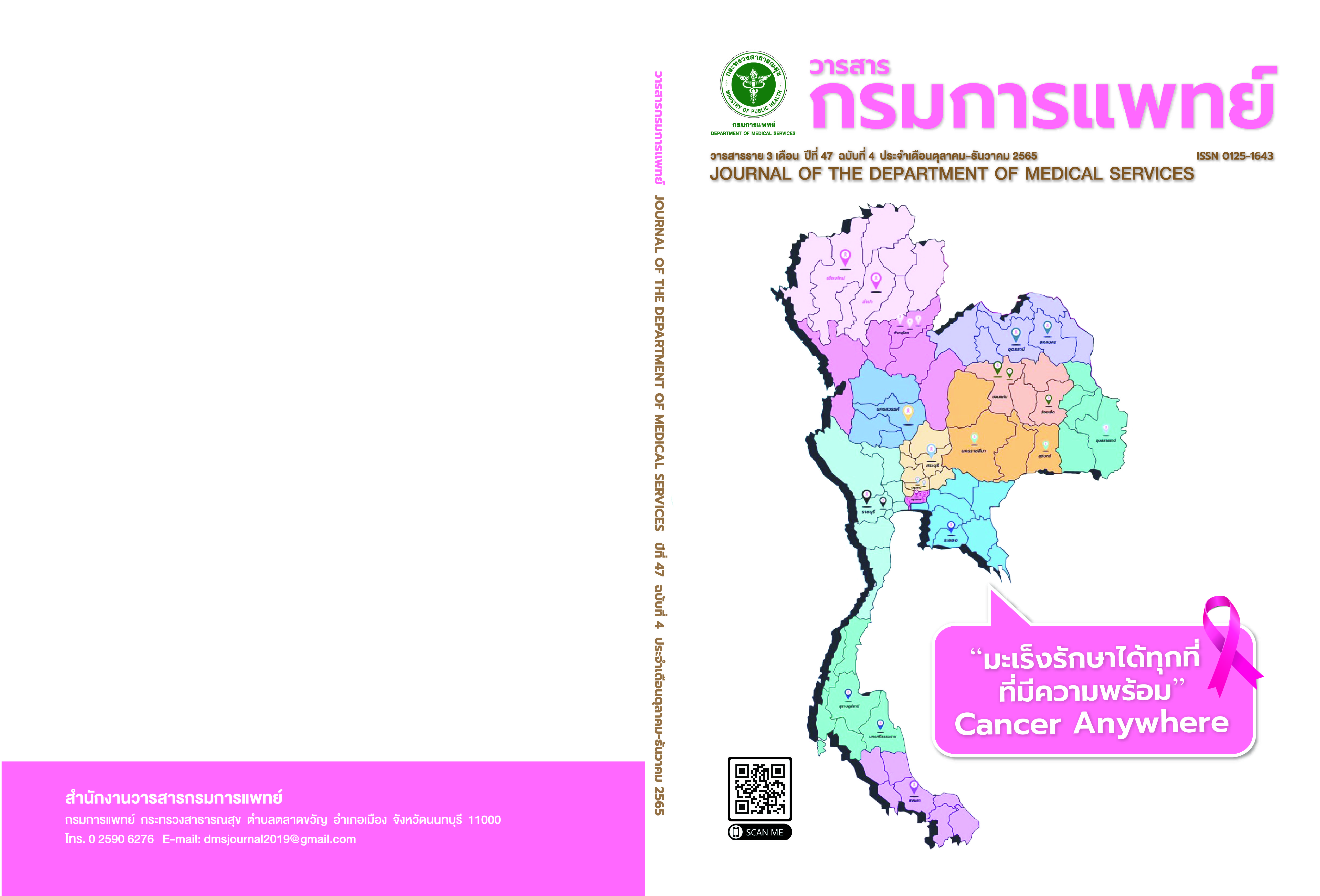Factors Related to Methadone Maintenance Treatment Outcome at Princess Mother Institute on Drug Abuse Treatment
Keywords:
Factors, Treatment, Methadone Maintenance TreatmentAbstract
Background: Opioids are highly dangerous substances. When an individual takes this drug unintentionally, itcan result in severe addiction. Methadone maintenance treatment is the main concept used to help patients reduceor quit the use of drugs and increase their quality of life. Objective: The purpose was to study the outcomes ofmethadone maintenance treatment at the methadone clinic in PMNIDAT. Method: This study was a retrospectivedescriptive study which had been implemented by applying medical record reviews of opioid addicts in the clinicfrom 2017 to 2021 (5 fiscal years). The data had been collected from 320 samples between 27th April to 31st May2022, using personal data records and treatment forms. The tool quality was examined by 3 experts with I-CVI(0.8) – 1.0, S-CVI (0.97) and by Cronbach’s alpha coefficient (0.83). The data were analyzed and shown by number,percentage, mean and standard deviation. The statistical analysis was implemented by using Chi-Square and Fisher’sexact test at the statistical significance level .05. Result: 41.3% of patients could reduce using heroin and 21.9%could quit using the drug. However, 28.8% of the patients remain in the treatment regimen, and 72.5% of them havereturned to work and study. The factors affecting the treatment outcomes were personal factors, which were age,occupation, education, marital status, history of opioid drug use, and incomes. The therapeutic factors were dailydose of methadone and the length of therapy stay. Conclusion: The treatment could result in good outcome ifenhanced by supporting factors, such as individual factors (age, occupation, and education). The therapeutic factorswere receiving enough dose of methadone and an appropriate length of treatment. Thus, to develop the mosteffective treatment system for this group of patients, therapists should use this information to develop an individualtreatment plan based on each patient’s conditions.
References
World Drug Report 2021, Executive summary policy implications.United Natioans Offce on Drugs and Crime (UNODC); [Internet]2021. [cited 5 Feb 2022] Available from: https://www.unodc.org/unodc/en/data-and analysis/ awdr-2021_booklet1.html.
Offce of the Narcotics Control Board. Nationwide drugsuppression results for the year 2021. Annual Report. Bangkok:Offce of the Narcotics Control Board; 2021.
Order of the Land Forces Center Overcome the National DrugAbuse No. 19/2556 regarding the Action Plan of the LandForce to Defeat Drugs in 2014; [internet] 2014 [cited 15 Jan 22].Available from: http://www.yasothon. go.th/web/Yaso_fles/images/ Zoneya/Master07.pdf.
Ukranan W. Methadone Maintenance Therapy in OpioidDependence: Review Literature. J DMS. 2017; 42:116-21.
Hubbard RL, Craddock SG, Anderson J. Overview of 5-year followup outcomes in the drug abuse treatment outcome studies(DATOS). J Subst Abuse Treat. 2003; 25:125–34
Grella CE, Wugalter SE, Anglin MD. Predictors of treatmentretention in enhanced and standard methadone maintenancetreatment for HIV risk reduction. J Drug Issues. 1997; 27:203–24.
Gibson A, Degenhardt L, Mattick RP, Ali R, White J, O’Brien S.Exposure to opioid maintenance treatment reduces long-termmortality. Addiction. 2008; 103:462–8.
Wimbush J, Amicarelli A, Stein MD. Does HIV test result influencemethadone maintenance treatment retention? J Subst Abuse.1996; 8:263–9.
Thailand Methadone Maintenance Service Standards Committee:Ministry of Public Health, 2015.
Sheikh Fathollahi M, Torkashvand F, Najmeddin H, Rezaeian M.Predictors of One-Year Retention in Methadone MaintenanceTreatment (MMT) in Iran, Rafsanjan. Int J High Risk Behav Addict.2016; 5:e29121.
Mertens JR, Weisner CM. Predictors of substance abuse treatmentretention among women and men in an HMO. Alcohol Clin ExpRes. 2000; 24:1525–33.
Darker CD, Ho J, Kelly G, Whiston L, Barry J. Demographic andclinical factors predicting retention in methadone maintenance:results from an Irish cohort. Ir J Med Sci. 2016; 185:433-41.
Deck D, Carlson MJ. Retention in publicly funded methadonemaintenance treatment in two Western States. J Behav HealthServ Res. 2005; 32: 43–60.
Mancino M, Curran G, Han X, Allee E, Humphreys K, Booth BM.Predictors of attrition from a national sample of methadonemaintenance patients. Am J Drug Alcohol Abuse. 2010; 36:155–60
Sarasvita R, Tonkin A, Utomo B, Ali R. Predictive factors fortreatment retention in methadone programs in Indonesia. JSubst Abuse Treat. 2012; 42: 239–46.
Pawjai Mahathep and Jirawat Thananarapong. Factors that affecttreatment outcome of opioid use disorder with communityparticipation in Maeteang ,Chiangmai province.TUH Journalonline Volume 3 No. 3 September-December 2018.
Thai Hoang & et al. Factors associated with concurrent heroinuse among patients on methadone maintenance treatmentin Vietnam: 24 – month retrospective analysis of a nationallyrepresentative sample. HHS Public Access. Int. J Drug Policy.2018; 55: 113 - 20.
Li Ming-li, LAN Guang-hua, Li Rong-Jian & et al. Five-yearretrospective cohort study for methadone maintenancetreatment among drug users in Guangxi. Chin J Public Health,Jan 2014 Vol.30 No.6.
Jia-Fu Lee, Shih-Mao Lo, Yun-Hsuan Chang, Yue-Cune Chang,Sheng-Yu Lee & Ru-Band Lu. Factors associated with retentionin a methadone maintenance treatment program in heroindependent Han Chinese in Taiwan. Neuropsychoiatry (London).2017, 7: 204-11.
Sirichai Kanchanawasee. Selection of appropriate statistics forresearch. (4th edition). Bangkok: Boonsirikan Print. 2001.
Alongkorn Takurngsakdaku. Factors associated with concurrentheroin use in methadone maintenance treatment patients inpsychiatric out-patient-unit at Samutprakan hospital. UdonthaniHospital Medical Journal Vol.25 No.2 May - August 2017, 171– 80.
Suwanmajo S, Duangrithi D, Komkla N, Phattanachot W andSathaporn U. One Year Retention Methadone MaintenanceTherapy at Princess Mother Institute on Drug Abuse Treatment.Journal of the Department of Medical Services, Vol. 44, No. 4July – August 2019, 119-24.
Thanita Hiranyatheb, Umaporn Udomsubpayakul and RonnachaiKongsakon. Factors Associated with Non-Relapse in Clientswho Completed the Rehabilitation Programme in CompulsoryTreatment System for Drug Addiction. J Psychiatr AssocThailandVol. 58 No. 2 April - June 2013, 157-64.
Chalowat Inpa and Pisit Sriprasert. Factors Affecting CompleteTreatment of Addiction Patients in Tak Province. Lanna PublicHealth Journal Volume 17 N0. 2 July – August 2021, 91-100.
Downloads
Published
How to Cite
Issue
Section
License
Copyright (c) 2022 Department of Medical Services, Ministry of Public Health

This work is licensed under a Creative Commons Attribution-NonCommercial-NoDerivatives 4.0 International License.
บทความที่ได้รับการตีพิมพ์เป็นลิขสิทธิ์ของกรมการแพทย์ กระทรวงสาธารณสุข
ข้อความและข้อคิดเห็นต่างๆ เป็นของผู้เขียนบทความ ไม่ใช่ความเห็นของกองบรรณาธิการหรือของวารสารกรมการแพทย์



